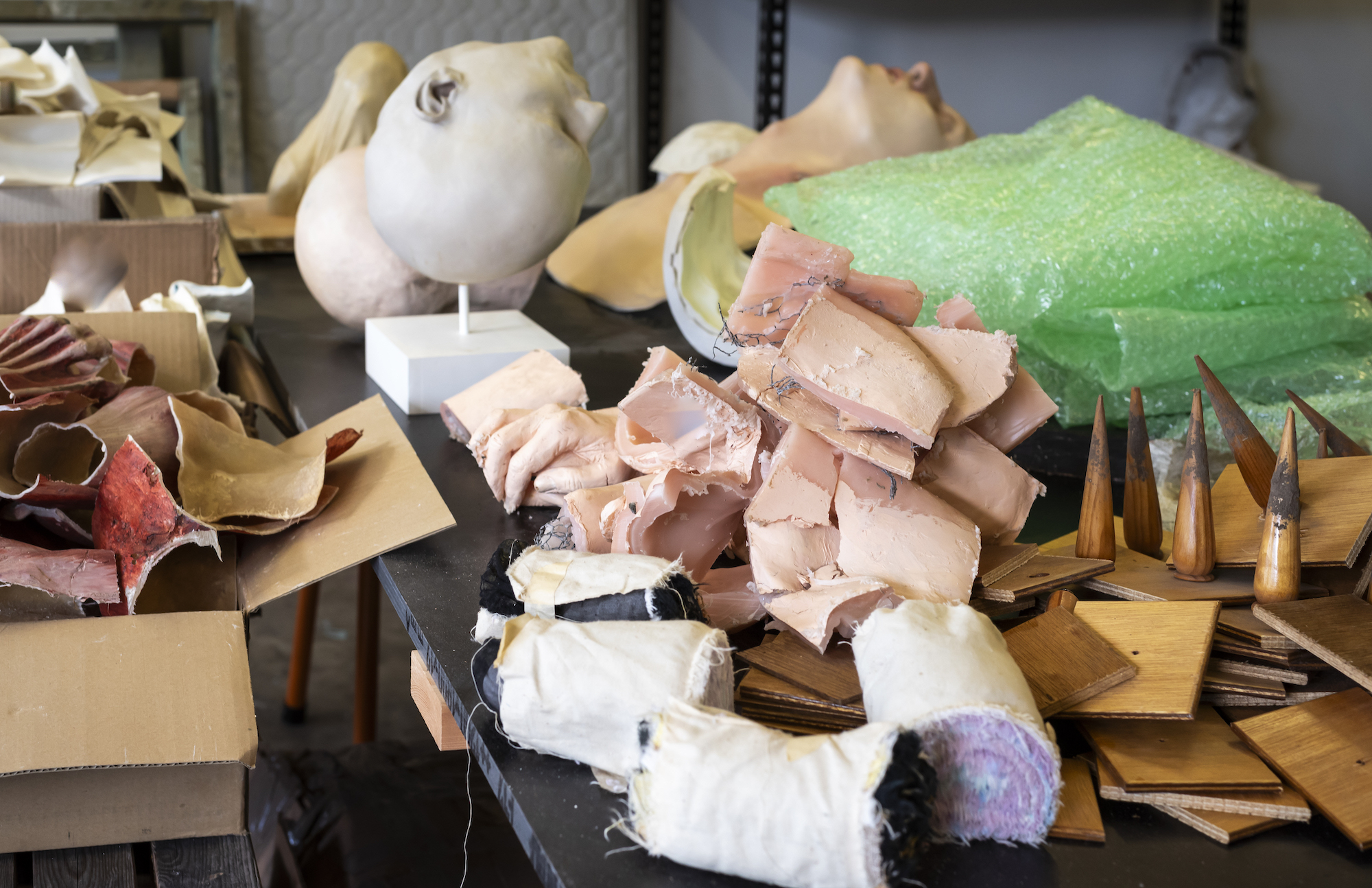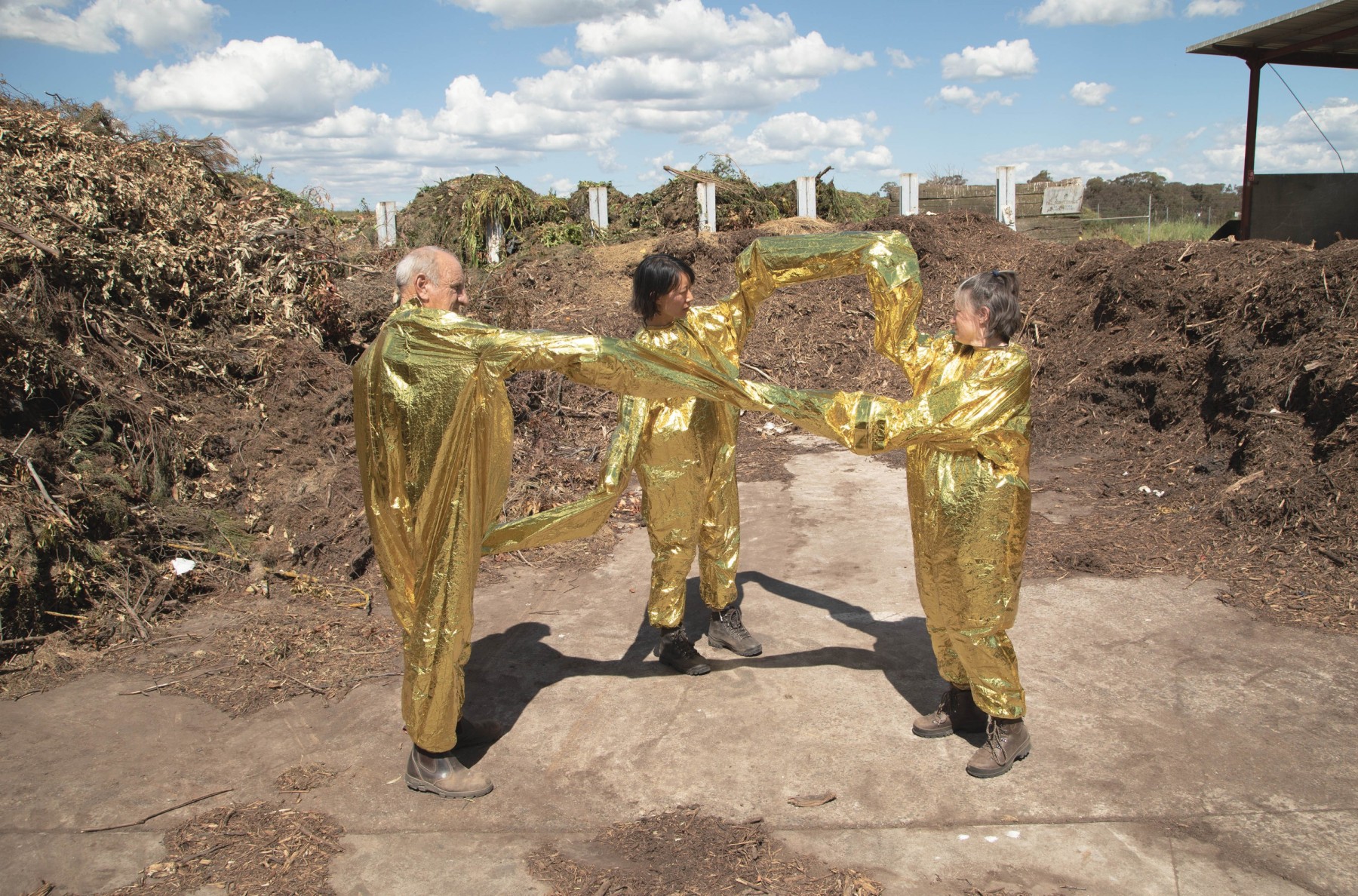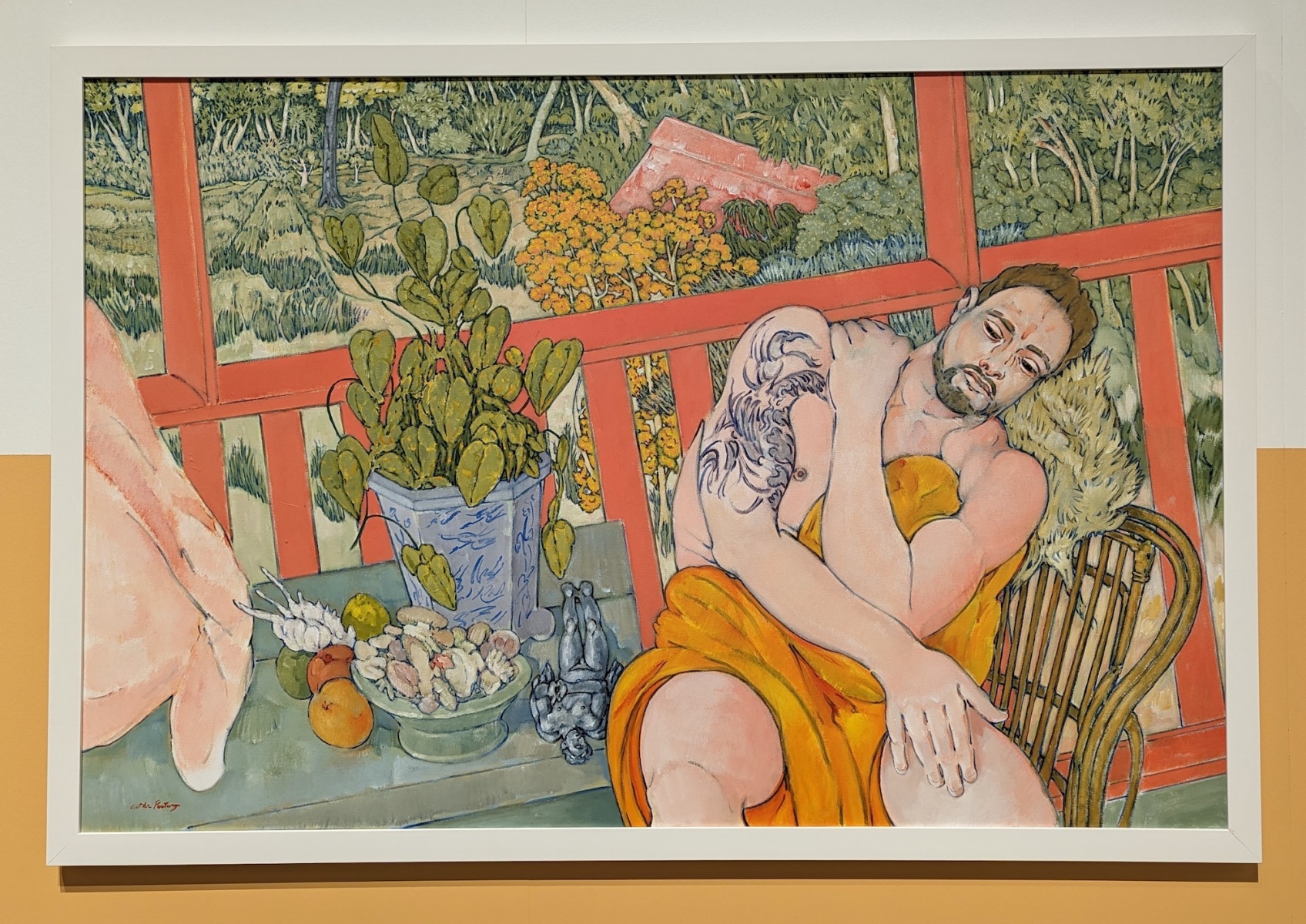Walking through Brisbane’s leafy Botanic Gardens on my way to Botanica: Contemporary Art Outside, the first thing I noticed was how well the artworks blend into the natural surroundings. Composed around the environmental theme ‘Tread Softly,’ Botanica features ten diverse installations, erected around the park and accessible between the hours of 5 and 10 p.m. The event also boasts a number of food trucks, an outdoor bar, guided walks, and live performances. And best of all, it’s completely free.
Walking up the main path, the first artwork you’ll see is Flow States (2023), a videographic/ceramic collaboration between Mel Robson and Ellis Hutch. Nestled in a bodhi tree, Flow States consists of thousands of porcelain screens onto which microscopic recordings of Australian waterlife have been projected. The juxtaposition of these complex, often unfathomable ecosystems with delicate, reflective ceramics creates a scene of strange beauty that invites a moment of quiet contemplation. When I visited, a young couple was lying on a picnic blanket beneath the tree, staring up into the branches, lost in thought.
Try as it might, Flow States can’t long distract from Theatre of Thunder’s adjacent installation. Dream Rupture, Earth Rapture (2023) takes centre stage at this event, mounted in the large rotunda above the Botanic Gardens’ public bathroom facilities. From a distance, Dream Rupture is reminiscent of a bubbling volcano. Up close, the mystery only deepens: clouds of vapour and bubbles stream out from beneath a mass of undulating tulle, moving in concert with an eerie, ambient soundtrack. As the wind shifts, the clouds drift through the park, transforming everywhere they touch into an ethereal dreamscape. The effect is both awe-inspiring and somehow unsettling, laying bare the transitory nature and daunting complexity of our natural world.
As I stood watching the tulle material sway within the billowing clouds, I overheard a group of people nearby debating whether or not the artwork concealed a human presence. After a few more minutes, they had their answer, as three figures rose from within the tulle and began to descend the steps toward the garden exit. The figures were faceless and inscrutable: masked and devoured by fabric, they contorted and staggered their way through the park with movements both organic and inhuman. This is one of Botanica‘s handful of live performances, scheduled to be repeated on closing night. Although Dream Rupture can be enjoyed without it, the performance adds an undoubtedly powerful element, provoking a response to the exhibition’s environmental theme that is more visceral than cerebral.
Moving away from the rotunda, Keemon Williams’ Ultra-Native Beast Sentinel (2023) looms over the park’s decorative flower gardens. This is Botanica’s single augmented reality installation, using QR codes to project a giant, robotic creature onto the tidy arrays of imported marigold and salvia flowers. Viewed through your phone screen, this beast—reminiscent of the extinction-vulnerable dingo—tosses its head and blinks its glowing red eyes. Positioned against the Botanic Gardens’ carefully tamed and ordered landscape, Ultra-Native Beast Sentinel is a powerful, primal instantiation of the natural world fighting back against the incursions of globalism and civilisation.
As I wandered deeper into the gardens, I soon found myself nearing the river, where Slow Art Collective’s Slow Botanica Pavilion (2023) sits on the very edge of the event space. Billed as “a night-time iteration” of their ongoing Archi-Loom project (recently exhibited as part of the Museum of Brisbane’s Play Moves), Slow Botanica Pavilion aims to transform a standard garden arbour into a playful hub for music and exchange. The structure glows in the dark, festooned with a multitude of fluorescent, UV-lit streamers, which visitors are invited to braid, weave, and otherwise manipulate in order to transform the space. Amidst the dangling ribbons, ad-hoc xylophones have been created for play and expression, encouraging spectators to shape not only the sight, but also the sound, of their environment.
After weaving a few strands into the pavilion, I headed down Central Path, searching for Christian Reitano, Lyn Nagayama, and Shelby Lee’s work. Where Are We Going? (2023) is a multimedia installation that combines sound, dance, and visuals to highlight the interconnectedness of nature and the environment. On a large screen suspended within the gardens’ lush Bamboo Grove, Nagayama dances in front of macrophotography projections of bushlands and riverbeds, accompanied by an urban soundscape. Nagayama will also perform live beneath the screen on the 20th of May.
Initially underwhelming amidst Botanica’s flashier, more confronting artworks, Where Are We Going? operates slowly, almost subliminally. The longer you watch, the more the lines between apparent opposites become blurred, the projections of natural environments beginning to look almost real as they undulate over Nagayama’s body, while the screen itself, embedded within the Botanic Gardens, starts to take on its own organic aspect. The urban soundscape undergoes a similar transformation, the hum of cars and people subtly evoking the rush of water or wind. The result is an unassuming artwork that confidently encapsulates one of Botanica’s driving preoccupations: the porousness of the barrier between nature and human artifice.
A short walk away is Light Lilies (2023), an interactive installation developed for Botanica by Dutch designers Noa Haim and Adriaan de Man. As the first international work to be featured in Botanica, which has been running yearly since 2018, Light Lilies has a high bar to clear, and does so with aplomb. Easily the most interactive and playful of the artworks on display, Light Lilies consists of a multitude of 3D polyhedrons constructed out of durable yet sustainable materials with a light source inside. As part of the installation, a central tower of polyhedrons has been preconstructed; materials and instructions for making more can be obtained at a nearby information booth. Indeed, by the time I arrived, the lawn was already littered with strange geometric shapes, each pulsing in a soft orange or purple hue.
In some ways, Light Lilies achieves what Slow Botanica Pavilion gestures towards: a truly playful, interactive experience that emphasises interconnectedness and cooperation. Inspired by the water lilies that once thrived in the Botanic Gardens’ lagoon, Light Lilies suggests that any attempt to heal the damage inflicted on the natural world is an inherently collaborative, playful experience. Children in particular will find the artwork delightful, but there’s no shortage of joy there for adults, too.
Similarly joyful is Soma Lumia’s Vestigia Arborum (2023), a captivating light and sound installation of dense strands of light draped from the branches of a massive tree. A pattern of lines and shapes is projected across the tree’s thick trunk, and music blasts a soundtrack composed by Jim Moginie of Midnight Oil from hidden speakers nearby. Spectacular enough in itself, the real magic of Vestigia Arborum lies in how it reacts to its human audience. By detecting mobile phones in the vicinity, the artwork changes as more people spectate, mirroring mankind’s unavoidable disruption of the natural environment. The more people gather, the more the pattern of lines and shapes become distorted, the more the music becomes frenetic.
Conceptually, Vestigia Arborum is a powerful statement on the human relationship to nature. Experientially, it’s marred slightly by its subtlety. During the ten or so minutes I observed the installation, I didn’t notice any change in the pattern or soundscape. Only by talking with a nearby staff member was I able to learn the full scope of the transformation: from sedate, meditative movements and music to a raucous, quasi-rave. To fully experience Vestigia Arborum, I would have needed to remain watching a while longer, but without benches or signage to encourage me to stay, I was soon drawn away by another artwork glittering in the distance.
Happily, Lyn Haddon’s Blue Butterfly Effect (2023) employs a similar concept with more successful results. Laid out along the Botanic Gardens’ majestic fig-tree-lined avenue, gorgeous blue butterflies made of aluminium and circuitry cluster around the tree trunks, showing off metallic, glittering wings. Similarly to Vestigia Arborum, Blue Butterfly Effect reacts to human presence, the robotic insects flapping their wings and glowing as people—and the phones in their pockets—approach. Unlike Vestigia Arborum, however, the layout of the artwork encourages people to move gradually from one tree to the other, making it easier to see how human presence affects the work. Furthermore, while the human influence on Vestigia Arborum causes the artwork to descend into chaos and distortion, Blue Butterfly Effect presents a more hopeful possibility: rather than a site of disruption, perhaps human/nature encounter can also be a place of gentle, surprising beauty.
The two artworks installed in the gardens’ Oakman Lagoon appear to share in this more optimistic interpretation of interactions between humans and the natural environment. Hills (2023), by Dan Luo and Weixin Huang, is the more immediately eye-catching of the two, consisting of a series of curved, glowing structures hovering over the surface of the water. The structures employ the Japanese weaving technique known as kagome, a traditional woven pattern used for making baskets and the kagome crest, a symbol associated with Shintoism. Reflected in the water below, these softly glowing shapes offer a stark counterpoint to the asymmetrical lines of Brisbane’s cityscape above. By combining kagome with an urban landscape and a futuristic architectural design, Hills offers an alternative vision of a high-tech future wherein traditional arts and cultures are deeply embedded—rather than eroded by—human modernity.
Finally, on the lower half of the Oakman Lagoon lies Phoebe Paradise’s Foundation (2023). A collection of miniature Queenslander houses rising out of the lagoon as though mounted on stilts, Foundation is at once familiar and alienating. Bathed in an eerie purple light, the houses themselves glow from inside, suggesting life and activity, while dark water sussurates below. At first glance, the habitations seem isolated, rising alone above the lagoon, but on second viewing, a slightly more cooperative vision emerges. Although separate, the houses sit in full view of each other, and some even appear to share resources or lines of communication, cables dangling from one porch to another. Foundation envisions a future in which human resilience has forced individualism and collectivism into an uneasy truce. In this unsettling, quasi-familiar dreamworld of Brisbane suburbia, humankind continues to adapt to its natural environment, repurposing old structures and nostalgias to address new ecological realities.
Botanica is a rare event perfectly tailored to its exhibition space. Despite the lack of signage and occasional issues navigating the event in the dark, the scattered placement of these ten environmentally focussed artworks throughout Brisbane’s Botanic Gardens is the ideal marriage of message and medium. Walking from installation to installation, I found myself relying less and less on my map and more on a combination of intuition and the beckoning shimmer of lights in the distance. There’s something magical in the experience of discovery engendered here, where I often found myself unsure of what was, and what wasn’t, art. Before long, I was approaching everything in the gardens with the same slow wonderment as a painting in a museum. By imploring us to “tread softly” in our natural environment, Botanica is also inviting us to slow down—and in so doing discover beauty in unexpected places.
Yen Radecki is a writer and editor currently based in Meanjin/Brisbane. Their short fiction has previously appeared in STORGY Magazine, Ibis House, and Forge Literary Magazine. Online, they can be found at @yenradecki.













